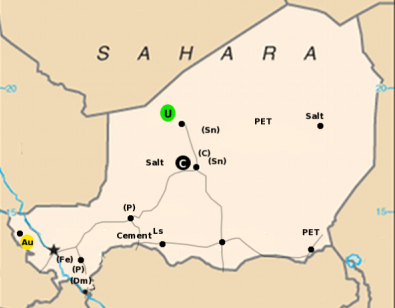Coal mining in Niger

Coal exploitation in Niger is carried out by Société nigérienne du charbon (SONICHAR, the coal corporation of Niger). SONICHAR was created in 1975. It operates an open pit coal mine in Anou Araren in the Agadez Region.[1] It also operates a power plant 2 km away from coal mine.
History
The potential of coal mining in Niger was first established in 1968 when coal reserves where discovered in Anou Araren by an exploration team led by the French Atomic Commission (Commissariat à l’énergie atomique). This discovery and the parallel discovery and exploitation of uranium mines in the same region of Niger lead to the creation of SONICHAR in 1975. The goal was to mine coal which will be used as a fuel to power the thermal power plants in order to supply power to Uranium mining activities in Arlit. In 1980, coal mining began at Anou Araren and a year later, the thermal power plant was in operation.
Production at Anou Araren
The coal production at Anou Araren in Agadez Region was 246 016 tonnes in 2011.[2] Of the total production, 210 879 tonnes (86% of total production) was used by the power plant in the same year.[3]
Anou Araren Coal Production and Consumption between 2007 and 2011
| 2007 | 2008 | 2009 | 2010 | 2011 | |
|---|---|---|---|---|---|
| Coal production (tonnes) | 171296 | 182912 | 225072 | 246558 | 246016 |
| Coal consumption by power plant (tonnes) | 145641 | 161640 | 172819 | 192047 | 210879 |
Data source: Yearly Statistical Report - Niger 2007-2011
Production at Salkadamna
In 2012, the government of Niger announced its intention to build coal mine in Salkadamna in the Tahoua Region after the discovery of a reserve of 92 million tonnes.[4] The goal of the project is build a mine with a production capacity of 1.1 million tonnes per year. The production is intended to supply fuel for a coal powered plant and to produce coal briquettes for local consumption. The power plant will have a total capacity of 200 MW with potential for expansion up 600 MW. It will have four units of 50 MW capacity each based on a fluidized bed combustion technology.[5] The coal briquette plant will aim for a production of 100 000 tonnes per year at start-up to potentially reach 300 000 tonnes per year at full speed.
References
- ↑ http://www.criirad.org/actualites/dossiers2005/niger/CRIIRAD_09-25_SONICHAR.pdf - Chemical Analysis of Waste Water from Coal Plant
- ↑ - Coal Production and Utilization 2007-2011 Report P218
- ↑ - Coal Production and Utilization 2007-2011 Report P218
- ↑ - Coal reserves in Salkadamna, Tahoua
- ↑ - Power plant (Click on "centrale" to reach page of interest)